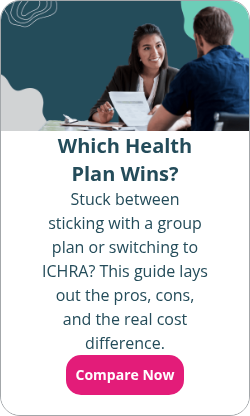What is stop-loss insurance?
By Elizabeth Walker on December 23, 2024 at 10:30 AM
If you’re an employer looking to offer group health insurance, you may look into a self-funded health plan instead of paying an insurance carrier for a fully-insured plan. In some cases, self-funded plans are more affordable than traditional group health insurance, especially if you have employees who rarely use their health benefit. But with self-funding comes the risk of costly medical claims which could leave your company financially strapped.
That’s where stop-loss insurance can help. It protects you from paying high-cost claims under your self-funded plan, helping you avoid surprise medical expenses. But how does it work, and how do you know if a self-funded plan and stop-loss insurance is right for your company?
In this blog post, you’ll learn:
- What stop-loss insurance is and how it offers financial protection for employers.
- The differences between specific and aggregate stop-loss insurance.
- The pros and cons of stop-loss insurance and how to determine if it’s the right fit for your organization.
What is stop-loss insurance?
Stop-loss insurance, or excess insurance, is coverage an employer buys to lessen the risk of a self-funded health plan. It shields employers against catastrophic expenses. That way, they don’t have to assume 100% liability for any “losses” under the plan.
Stop-loss policies only cover the employer. They don’t protect employees or their dependents. But, they indirectly benefit employees by maintaining the employer-sponsored health plan’s ability to cover their medical expenses.
Here’s how fully-insured plans compare to self-insured plans:
|
Plan type |
Fully-insured plans |
Self-insured plans |
|
How employers fund the plan |
With these policies, employers and employees pay an insurer a fixed premium for their employees enrolled in the plan. |
Self-insured employers pay for all eligible claims their employees incur. Employee contributions fund a portion of these claims, similar to a premium. |
|
Who covers medical claims? |
The insurance company covers enrolled employees’ medical claim expenses. |
The business assumes all the financial risks of providing benefits to its staff. |
|
Examples |
Examples include traditional group health insurance from an insurance carrier, and Small Business Health Options Program (SHOP) plans. |
Examples include traditional self-funded plans and health reimbursement arrangements (HRAs). |
Stop-loss plans protect employers with traditional self-funded plans against health claims that exceed a predetermined amount. This way, employees still receive essential coverage, and employers have a financial safeguard against unexpected healthcare costs.
How does stop-loss insurance work?
In some cases, insurers write stop-loss insurance through a trust. In this case, the trustee is the policyholder. The employer who applies for and accepts coverage is a “participating employer” in the trust. They'll receive a plan document outlining the policy’s benefits. However, this isn’t the case for every stop-loss policy.
Employers can also purchase stop-loss coverage from an insurance carrier. To determine which policy is right for you, consider the level of risk you want to take on and your preferred level of protection. You should also look at your workplace demographics, past medical claims data, and budget.
Stop-loss insurance payouts use a reimbursement model. You’re responsible for paying all your employees' claim costs upfront while they’re on your plan. Afterward, you’ll submit any eligible claims to your insurer to receive reimbursements for the amount that exceeds the plan’s deductible or attachment point. Payments always go to you. Employees, dependents, or medical providers don’t receive reimbursements.
Expenses must meet the following criteria to be eligible for reimbursement by your insurance carrier:
- It must be an eligible expense as defined in your benefit plan document.
- The loss must meet the definition of a loss outlined in your policy.
Reviewing your plan document is critical to understanding your financial liability. For example, a stop-loss carrier may have policies that don’t allow reimbursement for certain expenses. A misunderstanding can result in significant liability. So, examine it carefully with your insurer or broker before the plan period begins.
What are the types of stop-loss insurance?
There are two types of stop-loss coverage for employers. You can have one type of insurance coverage. But, many self-funded employers prefer to get both. Let’s discuss how each type can work for you.
Specific stop-loss health insurance
Specific, or individual, stop-loss insurance protects employees from a particular employee’s excessive medical costs. It can also cover excess claims from that employee’s dependents.
With individual stop-loss insurance, employers can receive reimbursements for medical services, prescription drugs, or both. You set a maximum liability amount per employee in your benefits plan. The policy reimburses you for the excess if the sum of claims from a single employee exceeds that amount.
Here’s an example of how stop-loss medical insurance works:
|
Your liability cap for the policy year |
A participant’s actual claims |
How much your policy will reimburse you |
|
$150,000 per person |
$158,000 for the year |
$8,000 |
The maximum liability amount per person can range between $10,000 and $1 million. But your carrier will outline the maximum liability they’re willing to take on in your policy’s contract terms.
Aggregate stop-loss insurance coverage
Aggregate stop-loss insurance covers excessive medical claims from all employees during a policy year. You receive reimbursements if your employees’ aggregate claims exceed your predetermined threshold or aggregate attachment point.
Here are the types of claims aggregate stop-loss insurance can cover:
- Medical
- Dental
- Vision
- Prescription drugs
- Short-term disability
Like a deductible, your aggregate attachment point is the total dollar amount of claims your enrolled employees must reach before your policy will reimburse you for additional expenses. Typically, the attachment point will be about 125% of anticipated claims for the plan year.
You can calculate your monthly aggregate attachment point using the following method:
- You and your insurance company determine the average expected monthly claims per employee. This will depend on the employer and their workforce makeup but often ranges from $200 to $500 per month.
- Multiply the amount by a percentage between 125% and 175% to generate a margin.
- Multiply the final amount by your plan’s monthly enrollment to get the aggregate attachment threshold or monthly deductible.
Aggregate stop-loss coverage can have a monthly or annual attachment point. With a monthly attachment point, the amount of claims you must cover before your insurer will help pay could change every month depending on the number of employees enrolled in your plan. If you have an annual attachment point, the amount you’re liable for depends on initial monthly estimates during coverage, which the insurer totals for the year.
If you choose an annual attachment point, many policies will offer you a lower amount than if you select a monthly attachment point.
What are the pros of stop-loss insurance?
If you have a self-funded insurance plan or are considering getting one, adding stop-loss coverage has many advantages.
Below are a few pros of stop-loss insurance:
- Financial stability. It protects you from the financial liability of catastrophic claims.
- Potential for low financial risk. Self-funded plans may have lower annual costs than fully-insured plans if your employees and their families are generally healthy. Adding stop-loss coverage will help keep costs manageable if claim volume is high.
- Flexibility. You can use specific and aggregate policies as individual coverage or bundle them together. You also have the option to buy them separately from a third-party insurer.
What are the cons of stop-loss insurance?
Even with all its advantages, some employers may see potential downsides to stop-loss insurance policies.
Below are a few cons of stop-loss insurance:
- Initial payments. You receive reimbursements for excess medical claims. But you’re responsible for each claim’s initial cost. You may wind up in financial distress if you don’t have money in your budget for potential claims.
- Coverage limits. Many stop-loss insurance policies have coverage limits. If you’re a larger employer who uses your policy often, you may not be able to receive loss reimbursements for all the claims you pay.
- Stop-loss lasers. Suppose you have an employee or group that’s high-risk. For example, an employee with chronic conditions or ongoing treatments. In that case, the stop-loss insurer may use medical underwriting to target them. This means you’ll have less stop-loss coverage for those particular high-risk employees. Or, the insurer may place a higher deductible on those employees. You should evaluate how a stop-loss laser may impact your overall financial risk.
Do I need stop-loss insurance with an HRA?
If you have an HRA, your employees can receive tax-free reimbursements for their healthcare costs. Depending on the type of HRA, this can include health insurance premiums and other out-of-pocket medical expenses.
The federal government considers HRAs self-funded employee benefit plans. But they offer employers greater cost-predictability than other self-funded insurance options. Because you set a fixed allowance for your employees, there’s no risk of unpredicted claims. Therefore, you’re unlikely to need stop-loss insurance with an HRA.
Here are some advantages of HRAs for employers:
- Employers choose a monthly allowance that best suits their company’s budget. Then, their employees can buy qualified healthcare costs with their own money and request reimbursement.
- You only reimburse your employees once they show specific proof they purchased an eligible medical expense.
- Any unused funds stay with you at the end of the plan year and if an employee leaves your company.
- They have no minimum participation requirements or annual rate increases.
- Reimbursements are income-tax-free for employees and free of payroll taxes for employers.
An HRA is a simple, budget-friendly way to offer your employees a meaningful health benefit with low risk to your company. Not only do they negate the need for stop-loss insurance, but they’re also a surefire way to improve employee satisfaction.
How to determine if stop-loss insurance is the right choice for your organization
Before getting a self-funded insurance plan and stop-loss policy at your organization, you should consider your employees’ health and potential financial risk.
If your workforce is generally young, healthy, and single, your financial risk for costly claims with a self-funded plan is lower. If an employee has a health emergency, your stop-loss coverage can bridge the gap without breaking the bank.
However, if your workforce is mostly older individuals or those with families, you may experience a higher frequency of claims. In this case, you might decide that waiting for reimbursements isn’t worth the initial, expensive claim payouts.
Companies with self-funded health plans typically purchase specific and aggregate coverage. But, monthly premiums and benefits vary with both coverage types. So, compare policy options at multiple insurers to ensure you lock in the best prices for your organization.
Lastly, reviewing your policy each year is vital to make adjustments based on your and your employees’ needs. For example, if you didn’t hit your deductible one year, you can lower the deductible or drop the coverage altogether. Or, if you frequently exceed your deductible, you can raise your threshold for the next policy period.
Conclusion
Stop-loss insurance can be attractive if you have a self-funded health benefit plan at your organization. It can help you combat rising medical costs and lower your company’s financial liability for expensive medical claims.
The right stop-loss coverage can make or break a self-funded health insurance plan. That’s why educating yourself on stop-loss insurance will set you up for success. Before getting started, speak with an insurance broker to help you understand your employees’ healthcare needs and your company’s potential financial burden.
This article was originally published on November 2, 2022. It was last updated on December 23, 2024.
Check out more resources
See these related articles

Level-funded vs. self-funded health plans
Compare level-funded vs. self-funded health plans. Learn the key differences in cost, risk, and flexibility to choose the best option for your business.

What is an administrative services only (ASO) benefit plan?
Learn what an administrative services only (ASO) benefit plan is and how it allows businesses to self-fund employee benefits with third-party support.

What is COBRA?
Wondering what COBRA insurance is all about? This post explains COBRA and its importance for individuals who recently lost their health coverage.



